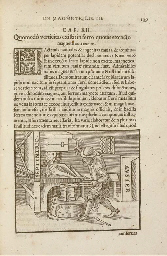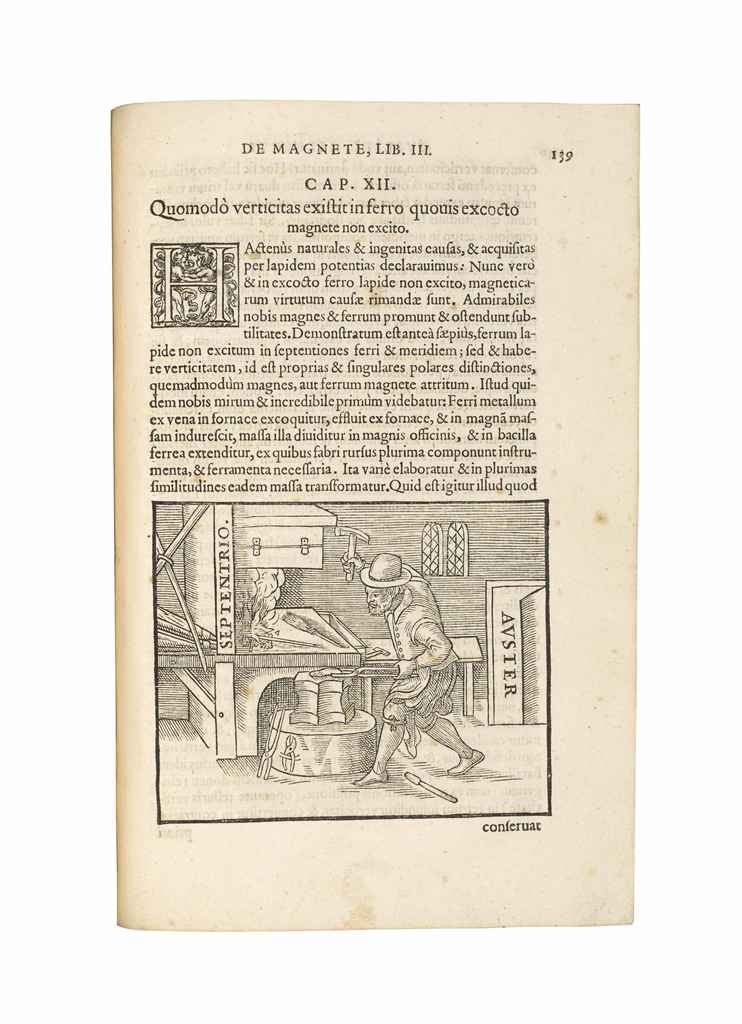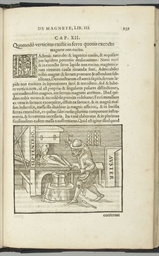GILBERT, William (1544-1603). De magnete, magneticisque corporibus. London: Peter Short, 1600.
GILBERT, William (1544-1603). De magnete, magneticisque corporibus. London: Peter Short, 1600. 2° (280 x 188mm). Woodcut title device and large woodcut arms on verso, 87 woodcuts in text of which 4 full-page and one folding, decorative woodcut initials and head- and tailpieces. (Some small burn holes sometimes affecting text, occasional light spotting and some small stains, light waterstaining to bottom corner of final 20 leaves and tiny clean tear at fold of folding plate.) Modern binding reusing old vellum (few small wormholes, some rubbing to extremities and light soiling). Provenance : removed ownership inscription on title. FIRST EDITION OF THE FIRST GREAT SCIENTIFIC BOOK PRINTED IN ENGLAND . ‘Gilbert coined the terms "electricity", "electric force" and "electric attraction" and may rightly be considered the founder of electrical science' (PMM); further, he ‘provided the only fully developed theory dealing with all five of the then known magnetic movements and the first comprehensive discussion of magnetism since the thirteenth-century Letter on the Magnet of Peter Peregrinus’ (DSB). De magnete exemplifies pre-Baconian experimental philosophy by supporting new theories with empirically-derived experimental evidence, and these experiments were described in sufficient detail for the reader to recreate them. Gilbert also described his scientific instruments in great detail, including new ones such as the ‘versorium’: the first instrument to be used for the study of electric phenomena. Gilbert observed that the earth was a gigantic magnet and provided a physical basis for the Copernican theory. His work was cited by Digby, Boyle, Kepler and Huygens, and Galileo drew on Gilbertian magnetism to support his belief in a Copernican heliocentric cosmology in his Dialogo . Dibner Heralds 54; Grolier Science 41; Norman 905; PMM 107; Wellcome 2830.
GILBERT, William (1544-1603). De magnete, magneticisque corporibus. London: Peter Short, 1600.
GILBERT, William (1544-1603). De magnete, magneticisque corporibus. London: Peter Short, 1600. 2° (280 x 188mm). Woodcut title device and large woodcut arms on verso, 87 woodcuts in text of which 4 full-page and one folding, decorative woodcut initials and head- and tailpieces. (Some small burn holes sometimes affecting text, occasional light spotting and some small stains, light waterstaining to bottom corner of final 20 leaves and tiny clean tear at fold of folding plate.) Modern binding reusing old vellum (few small wormholes, some rubbing to extremities and light soiling). Provenance : removed ownership inscription on title. FIRST EDITION OF THE FIRST GREAT SCIENTIFIC BOOK PRINTED IN ENGLAND . ‘Gilbert coined the terms "electricity", "electric force" and "electric attraction" and may rightly be considered the founder of electrical science' (PMM); further, he ‘provided the only fully developed theory dealing with all five of the then known magnetic movements and the first comprehensive discussion of magnetism since the thirteenth-century Letter on the Magnet of Peter Peregrinus’ (DSB). De magnete exemplifies pre-Baconian experimental philosophy by supporting new theories with empirically-derived experimental evidence, and these experiments were described in sufficient detail for the reader to recreate them. Gilbert also described his scientific instruments in great detail, including new ones such as the ‘versorium’: the first instrument to be used for the study of electric phenomena. Gilbert observed that the earth was a gigantic magnet and provided a physical basis for the Copernican theory. His work was cited by Digby, Boyle, Kepler and Huygens, and Galileo drew on Gilbertian magnetism to support his belief in a Copernican heliocentric cosmology in his Dialogo . Dibner Heralds 54; Grolier Science 41; Norman 905; PMM 107; Wellcome 2830.





.jpg)




.jpg?height=400)


.jpg)
Testen Sie LotSearch und seine Premium-Features 7 Tage - ohne Kosten!
Lassen Sie sich automatisch über neue Objekte in kommenden Auktionen benachrichtigen.
Suchauftrag anlegen